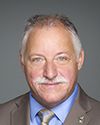Thank you, my dear colleague.
Mr. Chair, thank you for the invitation.
Thank you for the opportunity for us to provide this update.
My presentation does not appear on a screen. I invite you all to follow my presentation on the hard copy, which is in front of you.
Let’s go to page 2 to see the chart. As you can see, we have a complete linguistic services team. Let’s start with me: I am the Vice-President, Human Resources and in charge of labour relations. I report directly to the CEO, Mr. Rovinescu. Below, you can see my team which is responsible for linguistic services and for the implementation of linguistic services. You can also see to the right that we have close ties with union committees on bilingualism. We work closely with them.
Now, let’s move to page 3, in order to give you a little context and to relate to our last meeting. We are proud to be the national carrier, a leader in promoting bilingualism for all Canadian businesses. We have a legal obligation, but it is also our philosophy to offer the best services to the customers. Our obligations are therefore part of our policies and our programs.
Let's go to page 4. Our mission is to be a champion on a global scale. Our goal is to serve the travelling public in both official languages; to communicate with the general public in both official languages; to offer real opportunities to all of our employees in both official languages; and to ensure the engagement of our employees in each official language.
Let's go to page 5. It deals with our tools, both the existing ones and those that we have developed or improved since our last appearance. We have a linguistic policy, basically, to explain the why. We also have procedures to explain the how, the measures to be taken.
You can also see a few of our tools on page 6. You also have them in the folders in front of us and you can refer to them at your leisure. We have a brochure that explains everything, the why and the how. We distribute this brochure to new employees during all annual training, at all open houses, at every opportunity. We also have Aerovocab. It is a small dictionary available to our employees, and within easy reach. It is divided based on the operations, it contains terms for airports, terms for in-flight services, general air transport vocabulary and a small section on anglicisms to avoid, for example.
Let's go to page 7. You can see a small picture of the quick reference card that we created following our last appearance. We created this small laminated reminder that our agents at the airport can put in the pocket of their uniform. It contains short sentences that they often have to use during operations. There is also a phone number. If they are stuck, they can call colleagues who can help them and provide them with certain terms.
Let's go to page 8 and let me tell you a little about language training. You will notice that there is a menu of courses we offer. These are advanced courses for our employees who are already bilingual, but who want to improve their skills. They can take these courses as they see fit. You will see that, from 2015 to 2016, we provided 4,000 more hours to our employees. This means that our employees have had 4,000 additional hours to develop their language skills.
Let's now go to page 9. I want to talk to you about our awareness module. This video is on our portal. So all our employees have access to this video. Since we last appeared in the fall, we conducted an extensive campaign to make a larger number of our employees aware that this video is available. We are very proud to say that, in the fall, 4,000 more employees took this training.
On page 10, you see the percentage of all employees of the company who have completed this module. For airport baggage agents, the percentage is 95%. For airport agents, it is at 97%, and almost 90% of our flight attendants have completed this awareness module.
Page 11 is about communications. We have also increased our efforts in this area. Indeed, it is well known that, despite everything that we do, it is sometimes difficult to reach our employees because 85% of them are not office employees. It is not always easy for them to have access to our messages. We know that we must repeat them very often. What you see before you—also in your folders—is an example. This is our magazine Horizon, a monthly magazine that we distribute to all our employees, either online or in hard copy. In the fall, there was an article that spoke specifically of our linguistic obligations. We published it to ensure that our employees are aware of them.
Let's go to page 12. I wanted to talk a little about our partnership efforts. We also renewed our partnerships within communities to increase our pool of bilingual candidates. For example, we had booths at Seneca College in Toronto, at the Université de Saint-Boniface and we participated in the bilingual jobs exploration day in Halifax in November.
Let's go to page 13. I also wanted to point out that we are proud sponsors of certain events that encourage bilingualism, such as the Rendez-vous de la Francophonie, for example. Here you can see several other examples.
On page 14, there are more examples that you can look at at your leisure.
Let's go to page 15. I would like to share some numbers with you. You will see that more than 50% of our employees across the country who are in contact with the public are bilingual. The majority of people we hire throughout the country are also bilingual. There is only one exception, that of aboriginal people. Diversity and the hiring of Aboriginal people are important to us. So there are cases where we are hiring English-speaking Aboriginal persons who speak an Aboriginal language, but who do not necessarily speak French or another language used during our many routes. However, we believe that this is a worthwhile exception.
Let's go to page 16. I'd like to show you the progression in the number of bilingual employees in our operations from 2010 to today. You will see that rates have increased by 50% to 80%, depending on the type of operation.
On page 17, you can see the progression in the number of bilingual employees between 2010 and 2017. Once again, the data is distributed by region or airport in our case. Of course, in Montreal, we remain committed to 100%.
Let's go to page 18. I wanted to show you briefly that our linguistic obligations are part of our collective agreements, as they should be. Here you see an excerpt from the collective agreement with our airport agents.
On page 19, you see an excerpt from the collective agreement with our flight attendants. Please understand that it is important to have the support of unions in an industry where seniority prevails.
Let's go to page 20. I wanted to share with you a few more creative measures we put in place to promote bilingualism this past summer and fall, since we last met. We have created a network of ambassadors. They are champions in the field, passionate people who act as ambassadors for our programs. They help us communicate our obligations and our programs. They also conduct informal audits in the field from time to time.
On page 21, there are other creative methods. This is already part of our culture, a culture of cooperation and encouragement. We have incentive programs that are dedicated to the recognition of bilingualism. For example, we held an internal competition in the fall and early winter to encourage our employees to recognize their peers who are making an effort in terms of bilingualism.
I will conclude by saying that Air Canada is proud to be the most bilingual company in Canada. There is no doubt that we have obligations and we take them very seriously.
Since our appearance in June, we have really doubled our efforts to mobilize, to recognize our employees, to communicate and to recruit. We have developed new tools, for example reference cards. We have improved our tools, which you can view in the folder that we have provided.
Thank you, Mr. Chair.



